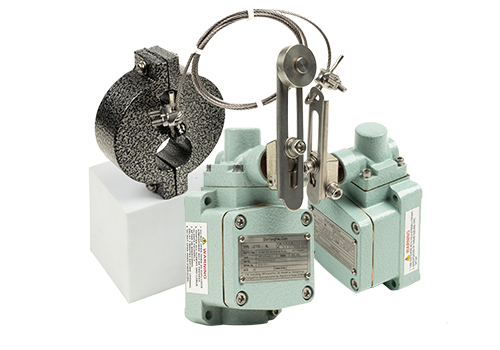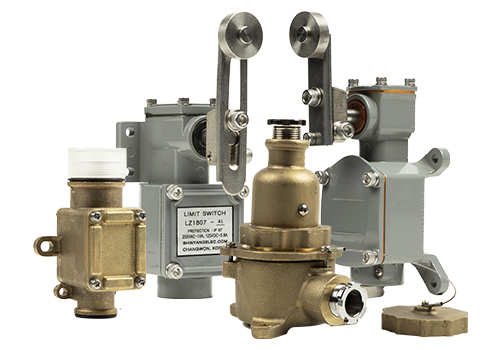- Introduction
- Product
-
Internal pressure Explosion-proof Limit Switch

Internal pressure Explosion-proof Limit Switch
-
Water & Dust-proof Limit Switch

Water & Dust-proof Limit Switch
-
Heavy-Duty Use Limit Switch

Heavy-Duty Use Limit Switch
-
Other switches

Other switches
-
Internal pressure Explosion-proof Limit Switch
- Limit Switch
- Commutity
Limit Switch
- Limit Switch
- Terms
Terms
Explanation of Terms
Some of the terms used in switches are defined in the KS, but they also include terms in general use and are explained below.
general term
| Micro Switch | It refers to a small-sized switch that has a micro contact gap and a snap action mechanism, and the contact mechanism that opens and closes with a specified motion and force is contained in a case and equipped with an actuator on the outside. (hereinafter referred to as a switch) |
|---|---|
| Limit Switch | This refers to a micro switch assembled in a metal case or resin case to protect it from external forces, water, oil, dust, etc. |
| rated value | In general, it refers to the quantity that serves as a guarantee standard for the characteristics and performance of the switch, such as rated current and rated voltage, and is subject to certain conditions. |
| contact point | Among the types of switches, it refers to one that has a switch function depending on the mechanical opening and closing of the contact point. |
| Contact type | It consists of electrical input/output circuits of contact points according to various uses. |
| Resin adhesion (Mold terminal) | This means that the terminal part is wired with a lead wire and then filled with resin to fix this part, eliminating exposed filling parts and improving filling properties. |
Lifespan Terms
| mechanical life | This refers to the switching life in a non-energized state by setting the movement after operation (OT) to a specified value. |
|---|---|
| electrical life | This refers to the switching life due to the rated load (resistive load) by setting the movement after operation (OT) to the specified value. |
Structure terminology

- OneheadHead
- In the case of a limit switch, the operating mechanism refers to the part with an independent mechanism.
- 2operating partActuator
- As part of a switch, it refers to a mechanism in which the external force applied to the actuator is transmitted to the internal spring mechanism to move the moving contact point to open and close the switch.
- 3caseCase
- It refers to the body that protects the mechanical part of the switch and is also called housing.
- 4switchSwitch
- It performs the switch function by mechanically opening and closing the contact points by receiving linear motion from the switch's operating part and head.
- 5conduit portConduit
- In particular, in the case of the limit switch, it refers to the wiring hole, and the sealing of the wire part is performed in this part.
Terms related to operating characteristics
| classification | Terms | abbreviation | unit | Justice |
|---|---|---|---|---|
| strength | Operating Force | OF | g, kg g-mm | Force applied to the actuator required to move from the free position (FP) to the operating position (OP) |
| ReleaseForce _ | RF | Force applied to the actuator required to move from the operating limit position (TTP) to the returning position (RP) | ||
| Total Travel Force | TF | Force applied to the actuator required to move from the operating position (OP) to the operating limit position (TTP) | ||
| movement | Movement until action (Pre travel) | P.T. | mm,° | Movement distance or movement angle from the free position (FP) of the actuator to the operating position (OP) |
| Movement after movement (Over Travel) | OT | Movement distance or movement angle from the actuator's operating position (OP) to the operating limit position (TTP) | ||
| Movement Differential | M.D. | Movement distance or movement angle from the operating position (OP) of the actuator to the returning position (RP) | ||
| Total Travel | TT | Movement distance or movement angle from the actuator’s free position (FP) to the operating limit position (TTP) | ||
| location | FreePosition _ | FP | mm,° | Actuator position of the operating part when no external force is applied |
| Operating Position | OP | The position of the actuator when an external force is added to the actuator and the movable contact point is exactly reversed from the free position (FP) state. | ||
| Release Position | RP | The position of the actuator when the external force of the actuator is reduced and the movable contact point is exactly reversed from the operating position (OP) state to the free position state (FP). | ||
Total Travel Position | TTP | Position of the actuator when it reaches the stop position |



